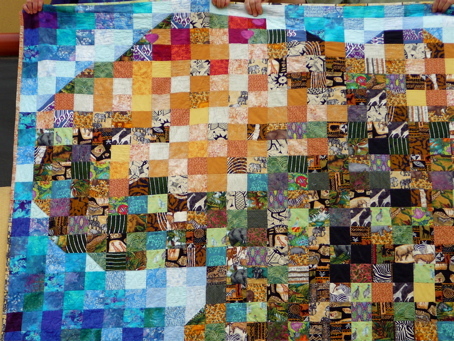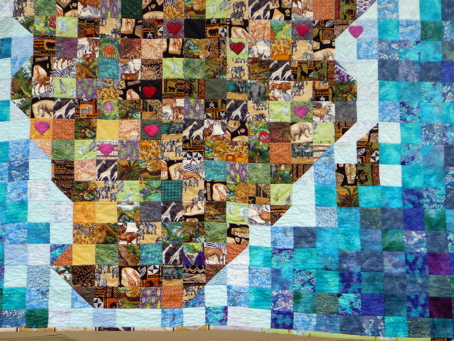Map Quilts
28 January 2008
These are all the map quilts in one place, with class instructions on how to make them:
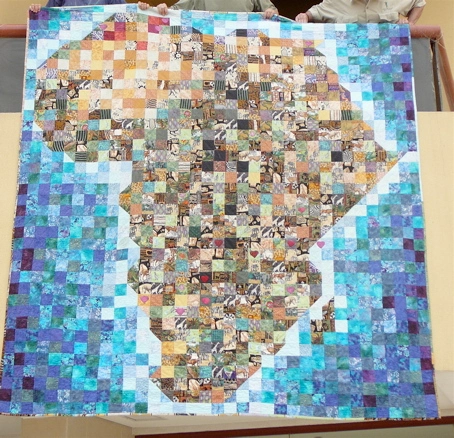
I left my Heart in Africa

Moroccan Dreams

Turkish Delight

African Kaleidescops

Lawrence of Kuwait
1. Start with a graph
Find the country you want to map, or state, or entire continent, and draw it onto your graph paper. It may change several times – that’s OK. You have time. Figure out what colors you want to use, and why. Identify any motifs you may want to use, appliqué, pieced or quilted. Figure out what you are going to do with the area that is NOT part of your focus country!
2. Gathering the Fabric
This actually takes the most time. You need many many different blues, for example, if you will have sea, shading from the very lightest to deeper purple, if it goes deep. You may want desert tones, or greens. You may want fabric from the country you are making, or you may want to appliqué something onto a square, and to identify where you will want it to go.
One really fun part is to ask your friends. You don’t need even a fat quarter, just scraps big enough for a couple squares. The greater the variety you acquire, the greater your flexibility in placement. As an example, I probably use 50 different “sea colors” ranging from the lightest blues to the deepest purples. My friends gave me Egypt fabrics, and Sudanese fabrics.
These first two steps can take months, or even years. You will come up with all kinds of amazing ideas. Keep your plans for your map quilt in one place, and write down your ideas when you think of them, so you don’t forget them.
3. Distributing the colors
I usually figure out where I want different colors – all the golds to almost white in the desert, for example, maybe this quadrant will be red. In the Africa quilt, I used pure black for some places where terrible things were happening. It helps the balance of the quilt to have colors grouped together, and that takes some planning. Also, now is the time to make any specialty blocks you may want to include.
Take a look at your fabrics, and at your graph. Figure out how big you want the quilt to be. In the first Africa quilt, for example, the smallest I could cut the giraffe fabric and still have it be effective was 3.5”. That one fabric, and my desire to use it, drove the entire quilt to its current huge size.
Even if you have been cutting fabrics all along, when you finally get to the point where you are ready to start – you will have to start with cutting. To have enough of every color, you just cut a lot. Even so, there are times when you will have to get up from sewing to cut some more.
I don’t go to a lot of effort to be accurate about terrain, but if you want to include a lake, or mountains, or something particular to that region, you can either use fabrics which show what you wish to emphasize, or you can create your own lake, or desert, or fields of flowers – it’s your quilt, you get to be the boss!
Mountains: You can make a large mountain by making it four squares big, white mountain with blue sky , for example, or black mountain with blue or white sky. As long as you have planned ahead, anything is doable. Smaller mountains can be exactly the same size as the other blocks. It’s just nice to have a little variety.
4. Execution:
Break your quilt into doable sections. You might use quadrants, and each quadrant usually has a dominant color. Cookie trays can keep the squares in some kind of graduated order. Always have the graph on the wall, so you can check it frequently, and use a project wall, where you can hang the completed sections and check them as you go along.
You might do two rows, sew them together, and then sew them directly to the section where they belong. It might seem fiddly, but it helps you keep track of where you are on the graph, and it helps you see where you might want to add more deep / light colors, etc. It is also just a lot of fun to watch it grow.
As you go along, check off each row as you complete it. Again, it may seem fiddly, but it is easy to get lost and confused, especially when you are working on a section of coastline, and you need to get the half-square triangles going the right ways!
5. Quilting and Embellishing
It has been so much fun, just watching all those colors come together and blend into a fabric collage of a country. Now is time when you can make it even more special.
Make the sandwich.
Do a quarter inch outline of the continent/country you are working on, very first thing. It helps keep everything stable, and it gives your focus some definition.
If there are particular quilting motifs you want to use – a mariner’s compass in the sea, for example, or camels crossing the desert, or a hand of Fatima, or a teapot – you’ve been gathering them all together, and now you get to have the fun of putting them in.
You might want to do waves, and spirals, and fish in the sea. You might have your own ideas to make this quilt uniquely your own creation, and now is the time to explore them. These map quilts are not serious quilts, they are supposed to be fun. 🙂
6. Surprise.
In every map quilt I do (and in many of the others) I put a surprise. In the Morocco Dreams quilt, I put a camel in the desert, so big you couldn’t see him unless you stood about ten feet away. He was in slightly lighter colors than the rest of the desert. I also outlined him in hand quilting.
You might want to machine quilt in the name of the person for whom you are making the quilt, the date and the place. You might want to machine embroider your own name in the quilt, in an inconspicuous spot, where some quilt-heritage researcher may someday find it and rejoice! Most of all, this is where you can have fun with embellishing the map so that it tells something about why you chose this country, something about how you feel about this subject. Here is where you can use charms and beads and crystals to highlight special and unique qualities.
Photos and more instructions at : worldquilter.wordpress.com. Click on map quilts under categories, over on the right hand side.



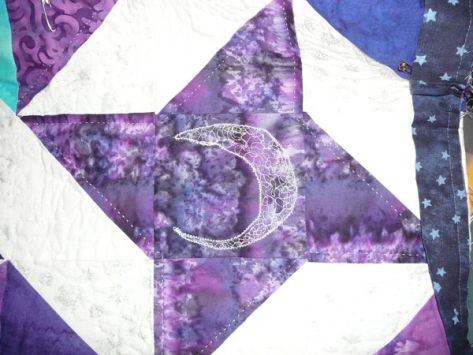
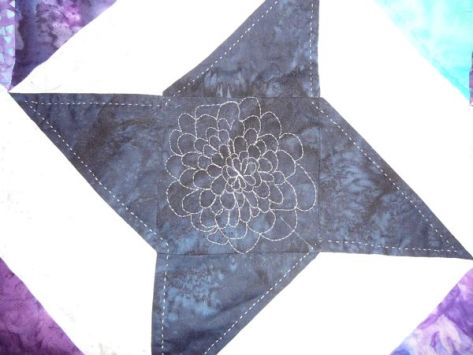

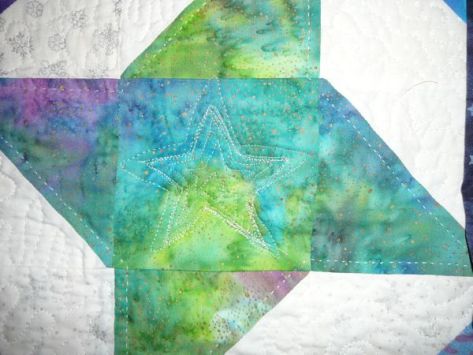
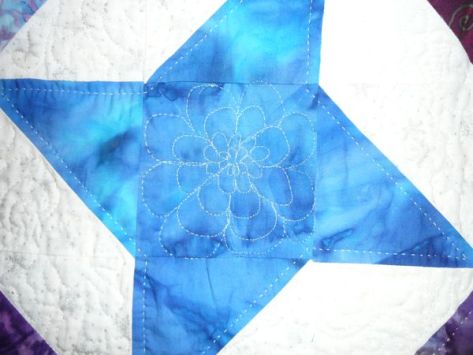


































 The top border:
The top border: Square:
Square: As I look at it closely, I remember all the hand quilting I used to do:
As I look at it closely, I remember all the hand quilting I used to do:
